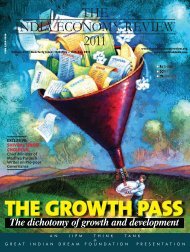Download - The India Economy Review
Download - The India Economy Review
Download - The India Economy Review
You also want an ePaper? Increase the reach of your titles
YUMPU automatically turns print PDFs into web optimized ePapers that Google loves.
P LANNING P ARADIGM<br />
Table 3: Growth Rate Performance in the Five Year Plans<br />
SL Plan Target Actual<br />
1 First Plan (1951-56) 2.1 3.60<br />
2 Second Plan (1956-61) 4.5 4.21<br />
3 Third Plan (1961-69) 5.6 2.72<br />
4 Fourth Plan (1969-74) 5.7 2.05<br />
5 Fifth Plan (1974-79) 4.4 4.83<br />
6 Sixth Plan (1980-85) 5.2 5.54<br />
7 Seventh Plan (1985-89) 5.0 6.02<br />
8 Eighth Plan (1992-97) 5.6 6.68<br />
9 Ninth Plan (1997-2002) 6.5 5.5<br />
Note: <strong>The</strong> growth targets for the fi rst three plans were set wit respect to National Income. In the Fourth Plan it was the Net Domestic Product. In all<br />
Plans thereafter is has been the Gross Product at factor cost.<br />
problems by Gadgil Formula of 1969, was<br />
subsequently modifi ed in 1991 with<br />
weightage of 7.5% each for performance<br />
and special problems, with the performance<br />
weightage objectives.<br />
Similarly Finance Commission have<br />
also been changing the criteria of fi xed<br />
transfers to the states. While the Tenth<br />
Finance Commission give a weightage of<br />
10% to tax effort calculated as per formula<br />
evolved by it, the Eleventh Finance<br />
Commission not only reduced the weightage<br />
to fi ve percent but also changed the<br />
manner of computing the states share on<br />
the basis of tax effort and further introduced<br />
fi scal discipline as criteria with<br />
7.5% weightage. <strong>The</strong>re is some degree of<br />
confusion in the State Governments resulting<br />
from these frequent changes in<br />
the choice of criteria, assignment of<br />
weightage and method of computation of<br />
share of individual states. <strong>The</strong>re is a felt<br />
64 THE IIPM THINK TANK<br />
need for not only care in the choice of<br />
criteria and for balance in the assignment<br />
of weights, but also a measure of stability<br />
and continuity regarding this.<br />
<strong>The</strong> role that the Planning Commission<br />
plays in the examination and approval of<br />
state plans will call for close consideration<br />
as, on the political fi rmament there<br />
have been signifi cant changes with different<br />
political parties and their combinations<br />
coming to power at the Centre and<br />
in the States. Demurring voices about non<br />
clearance of schemes and projects by the<br />
centre are now more common and strident<br />
than they were in early decades of<br />
planning. Unless the Planning Commission<br />
is so re-constituted as to bring in<br />
expertise and local knowledge regarding<br />
the various regions and states, the planning<br />
process may continue to suffer from<br />
the unwillingness of states to accept the<br />
Yojana Bhavan dictates and advices.<br />
Between 1950-51 & 1980-81 the share of<br />
Agriculture went down to 41.8%, while<br />
that of Industry increased to 21.5%<br />
What is urgently needed is a substitution<br />
of the well meant but rarifi ed academic<br />
wisdom of of Yojana Bhavan by statesspecifi<br />
c development strategies with adequate<br />
appreciation of the local needs<br />
and persisting differences in the resource<br />
endowments and levels of development of<br />
the various States.<br />
Change in Structure<br />
An important aspect of the economy in<br />
the fi rst three decades of plan development<br />
was the change in its structure, slow<br />
in the fi fties and quite noticeable in the<br />
sixties and seventies. Between 1950-51 and<br />
1980-81 the share of Agriculture went<br />
down from 59.2% to 41.8% while that of<br />
Industry increased from 13.3% to 21.5%<br />
even as the share of Services rose from<br />
27.5% to 36.9%. <strong>The</strong> next 25 years between<br />
1980-81 and 2005-06 saw sharp<br />
decline in the share of agriculture in GDP<br />
from 41.8% to 21.7%, slow rise in share of<br />
Industry from 21.5% to 24.1% and signifi -<br />
cant increase in the share of services from<br />
36.7% to 54.2%. <strong>The</strong> structural change<br />
needs to be more clearly considered in<br />
setting priorities for plan investments.<br />
Growth Performances of the Past<br />
<strong>The</strong> FYP set out growth targets for<br />
achievements and indicated plan outlays<br />
with investment quantum, budgetary support<br />
and extra budgetary resources. <strong>The</strong><br />
growth targets for the fi rst three FYP<br />
were set out with respect to national income.<br />
<strong>The</strong> fourth FYP set out growth<br />
with target interest of net domestic product<br />
and all subsequent FYPs have set<br />
targets for growth of GDP at factor cost.<br />
Looking back, we notice that while the<br />
plan outlays increased from Rs. 1960<br />
crores in I FYP to Rs. 1,525,639 crores in<br />
X FYP the average growth rate of Gross





